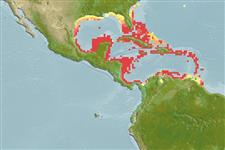Common names from other countries
>
Eupercaria/misc (Various families in series Eupercaria) >
Labridae (Wrasses) > Corinae
Etymology: Thalassoma: Greek, thalassa = the sea + Greek, soma = body; the colour of the sea (Ref. 45335).
More on author: Bloch.
Environment: milieu / climate zone / depth range / distribution range
Sinh thái học
Biển Cùng sống ở rạn san hô; Mức độ sâu 0 - 40 m (Ref. 9710), usually 3 - 30 m (Ref. 27115). Tropical; 23°C - 26°C (Ref. 27115); 34°N - 7°N, 99°W - 58°W
Western Atlantic: Bermuda, Florida (USA), southeastern Gulf of Mexico and throughout the Caribbean Sea to northern South America.
Bộ gần gũi / Khối lượng (Trọng lượng) / Age
Maturity: Lm ? range ? - ? cm
Max length : 25.0 cm TL con đực/không giới tính; (Ref. 26340); Tuổi cực đại được báo cáo: 3.00 các năm (Ref. 3420)
Short description
Hình thái học | Sinh trắc học
Các tia vây lưng cứng (tổng cộng): 8; Các vây lưng mềm (tổng cộng): 12-13; Tia cứng vây hậu môn 3; Tia mềm vây hậu môn: 10 - 11. Body elongate; 3 primary color phases, the smallest with a black mid-lateral stripe which continues as pale red blotches on head; back above stripe yellow on reef fish and whitish on fish from inshore non-reef areas, and body below white. The largest phase, has a bright blue head and a green body with two broad vertical black bars anteriorly which are separated by a light blue interspace; this phase is always male. The small yellow phase with the black stripe may be either male or female (Ref. 13442).
Inhabits reef areas, inshore bays and seagrass beds. Feeds mainly on zooplankton and small benthic animals, but may also feed on ectoparasites of other fishes (Ref. 9626). Spawn at midday throughout the year (Ref. 26938). A protogynous hermaphrodite (Ref. 55367). Generally of no interest to fisheries because of its small average size (Ref. 5217).
Life cycle and mating behavior
Chín muồi sinh dục | Sự tái sinh sản | Đẻ trứng | Các trứng | Sự sinh sản | Ấu trùng
A diandric species (Ref. 55367). Sex reversal is completed in more than 3-4 weeks (Ref. 34185, 34257). Length at sex change = 8.3 cm TL, forms leks during breeding (Ref. 55367).
Robins, C.R. and G.C. Ray, 1986. A field guide to Atlantic coast fishes of North America. Houghton Mifflin Company, Boston, U.S.A. 354 p. (Ref. 7251)
IUCN Red List Status (Ref. 130435)
CITES (Ref. 128078)
Not Evaluated
Threat to humans
Harmless
Human uses
Bể nuôi cá: Tính thương mại
Các công cụ
Special reports
Download XML
Các nguồn internet
Estimates based on models
Preferred temperature (Ref.
115969): 25 - 28.1, mean 26.8 (based on 222 cells).
Phylogenetic diversity index (Ref.
82804): PD
50 = 0.5000 [Uniqueness, from 0.5 = low to 2.0 = high].
Bayesian length-weight: a=0.00891 (0.00512 - 0.01553), b=3.02 (2.87 - 3.17), in cm Total Length, based on LWR estimates for this species & Genus-body shape (Ref.
93245).
Mức dinh dưỡng (Ref.
69278): 3.3 ±0.1 se; based on diet studies.
Thích nghi nhanh (Ref.
120179): Chiêù cao, thời gian nhân đôi của chủng quần tối thiểu là dưới 15 tháng (k=0.7; tmax=3).
Fishing Vulnerability (Ref.
59153): Low vulnerability (20 of 100).
